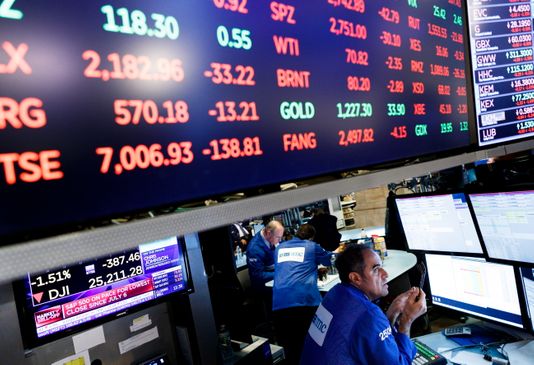
The Dow fell nearly 800 points Tuesday as investors worried about a bond-market phenomenon signaling a possible economic slowdown. Lingering worries around U.S.-China trade also sent jitters down Wall Street.
The Dow Jones Industrial Average declined closed down 799.36 points, or 3.1 percent, to 25,027, led by losses in Apple. Shares of Apple dropped 4.4 percent after HSBC downgraded the company’s stock to hold from buy as it faces “the reality of market saturation.” The S&P 500 declined 3.2 percent as the financials sector lagged. The Nasdaq Composite dropped 3.8 percent.
The yield on both the two-year and the three-year Treasury notes surpassed its five-year counterpart on Monday. When a so-called yield curve inversion happens — short-term yields trading above longer-term rates — a recession could follow, though it is often years away after the signal triggers.
Jeffrey Gundlach, CEO of Doubleline Capital, told Reuters this inversion signals that the economy “is poised to weaken.”
Lower long-term rates put pressure on bank stocks. The SPDR S&P Bank ETF (KBE) dropped 5.3 percent. Shares of J.P. Morgan Chase, Citigroup and Bank of America all declined more than 4.5 percent.
“No good deed goes unpunished,” said Art Hogan, chief market strategist at B. Riley FBR. “As we get headwinds from trade worries fading, you get an inverted yield curve and another brick added to the market’s wall of worry.”
Further fears of an economic slowdown were stoked by weaker-than-expected quarterly guidance from homebuilder Toll Brothers. The company issued its forecast for the first quarter. Toll Brothers also pointed to negative reports about the housing market as the cause for the slowdown. New home sales have fallen for 11 straight months.
Doubt about a permanent deal between the U.S. and China crept into investors’ minds following a stellar rally in the previous session.
The U.S. and China agreed over the weekend to hold off on any additional tariffs on each other’s goods on January 1, in order to allow trade talks to continue. Leaders from the two countries met over dinner at the G-20 summit in Argentina. The news sent stocks surging on Monday, with the Dow rallying more than 300 points.
But discrepancies over when that truce would begin has led to confusion. While President Donald Trump’s economic advisor, Larry Kudlow, told reporters Monday that the cease-fire would start from January 1, the White House later issued a corrected statement saying that the 90-day truce period would start on December 1.
“Bottom line, yesterday’s price action further confirmed that while clearly there has been some important macro clarity provided, we need to see more before we can expect the S&P 500 to make a serious challenge to the old highs,” said Tom Essaye, founder of The Sevens Report.
China and the U.S. have been engaged in a tense sparring match over trade, with both countries hitting each other’s economies with levies on imported goods. Trump’s administration has so far slapped tariffs on $250 billion worth of Chinese imports, while Chinese President Xi Jinping’s government has imposed tariffs on $110 billion in U.S. goods.
Trump said in a series of tweets Tuesday that a deal between the two countries would get done if possible. “But if [it’s] not possible remember … I am a Tariff man.”
























